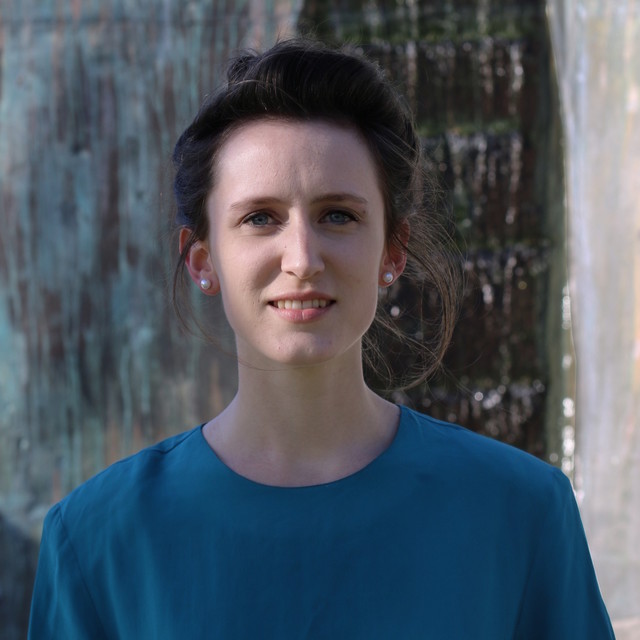SOUNZ recently caught up with composer Celeste Oram and violinist Keir GoGwilt to discuss 'a loose affiliation of alleluias', Celeste's SOUNZ Contemporary Award | Te Tohu Auaha nominated concerto for improvising violinist, vocal trio and orchestra.
Tell us a bit about ‘a loose affiliation of alleluias’.
(Celeste) Well, perhaps needless to say, the title is a Graceland reference: “…staccato signals of constant information, a loose affiliation of millionaires and billionaires and, baby, these are the days of miracles and wonder”. I know an art professor who periodically peppers his speech with Paul Simon lyrics. So I guess it’s become a kind of liturgy.
How did the opportunity to write this piece come about?
(Celeste) This is very much a "spirit of UCSD" piece - UC San Diego being where Keir and I are both doing PhDs. Which is to say, a lot of people mucked in, both onstage and off, to make it possible. Steven Schick is (among other things) a professor at UCSD, and artistic director and conductor of the La Jolla Symphony Orchestra: an adventurous, high-calibre amateur orchestra. Steve is an energetic supporter of contemporary music—especially emerging composers—and commissions a wealth of new works.
At least one piece each year on the La Jolla Symphony's programme is a new piece by a UC San Diego grad student - so I was lined up to write a piece. Steve and Keir were already talking about doing Robert Schumann's violin concerto on a LJSO concert - so the three of us put two and two together and agreed that my LJSO piece would be a "companion" violin concerto for Keir.
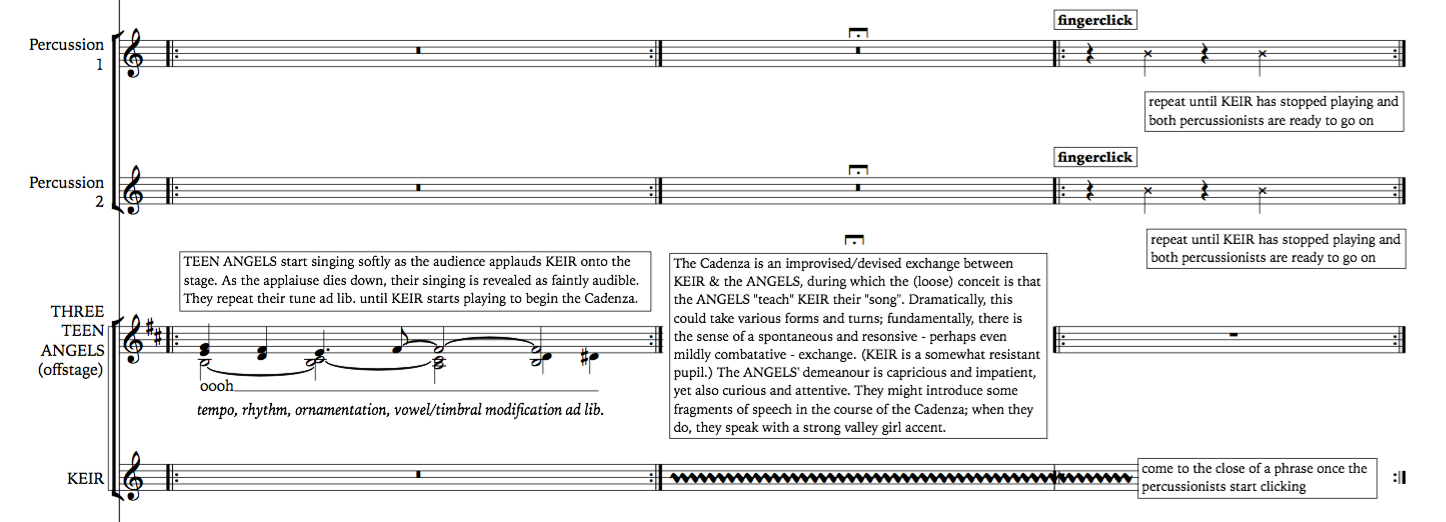 'a loose affiliation of alleluias', opening.
'a loose affiliation of alleluias', opening.
How did you design the formal/dramatic structure of this piece?
(Celeste) The first decision was the instrumentation; Steve and I agreed to use the same orchestral forces as the R Schumann concerto (but plus percussion). That chamber lineup really appealed: because it required I re-think my approach to orchestral writing. I reflected on the previous orchestral pieces I'd written - always for pretty big orchestras - and lamented that I hadn't written awesome wind parts. All the action was in the strings - they were the musical engine. As a wind player, this disappointed me! I've always remembered John Elmsly's orchestration advice: "Imagine you're the 3rd oboist, and that part is all you see. Would you like your own piece?"
So, in this piece, the orchestrational mechanics revolve around its 12 wind players. Auxiliary instruments give a sense of 12 very distinctive solo voices: piccolo, alto flute, oboe, cor anglais, E flat clarinet, bass clarinet, bassoon, contrabassoon - and then one of each trumpet and horn are muted.
I reflected that the winds are the choir of the orchestra; they’re voices. I’d been writing a number of contrapuntal vocal works - two and three voices - so I thought, okay, next step, 12 voices! But, historically, a "20 voice motet" isn't literally 20 voices at once - it’s four 5-voice choirs used spatially and antiphonally. So I took a leaf out of Renaissance church music and gave the wind section the cori spezzati treatment. The 12 winds became three quartets, organised by range: a high "superius" choir, a mid-range "cantus" choir, and a low "tenor" choir.
In this arrangement, with the winds driving the bus, the strings would, musically speaking, take a back seat: they would be sympathetic strings to the solo violin, and be slowly coaxed to life. I’m also always mindful of the striking theatrical presence of the string section, whether or not they’re playing: they’re the corps-de-ballet; they set the scene.
I should mention that Cassandra Miller's 'Duo for Cello and Orchestra' was a substantial influence: its slow-burn orchestration, and the patient stoicism of its solo cello, makes it a fascinating anti-concerto. That prompted me to put a lot of thought into exactly what kind of musical and dramatic agency Keir would have as a soloist in this piece, and how that would inevitably comment on the persona of the soloist in the Romantic concerto tradition.
And I wanted there to be voices, largely as an excuse for me to sing in three-part harmony with my friends and fellow composers Barbara Byers and Lauren Jones. But I hate singing solo in front of an audience… so I positioned us offstage: where I wouldn't panic, and whence these disembodied voices would be a nod to the R Schumann concerto. (Its second movement theme was dictated to Schumann by a choir of angels, so he professed.)
So you can see all these orchestrational decisions established a kind of “dramatis personae”, each character with their own role, backstory, and agency.
Another puzzle piece: early on I decided the piece would take the structure of a modern pop song - intro, verse 1, chorus, instrumental, verse 2, chorus, instrumental, bridge, chorus, outro/fade. (A nod to The Boy in the Bubble.) I like working with and against the grain of “imposed” form - especially forms from vernacular song, be they ancient or modern.
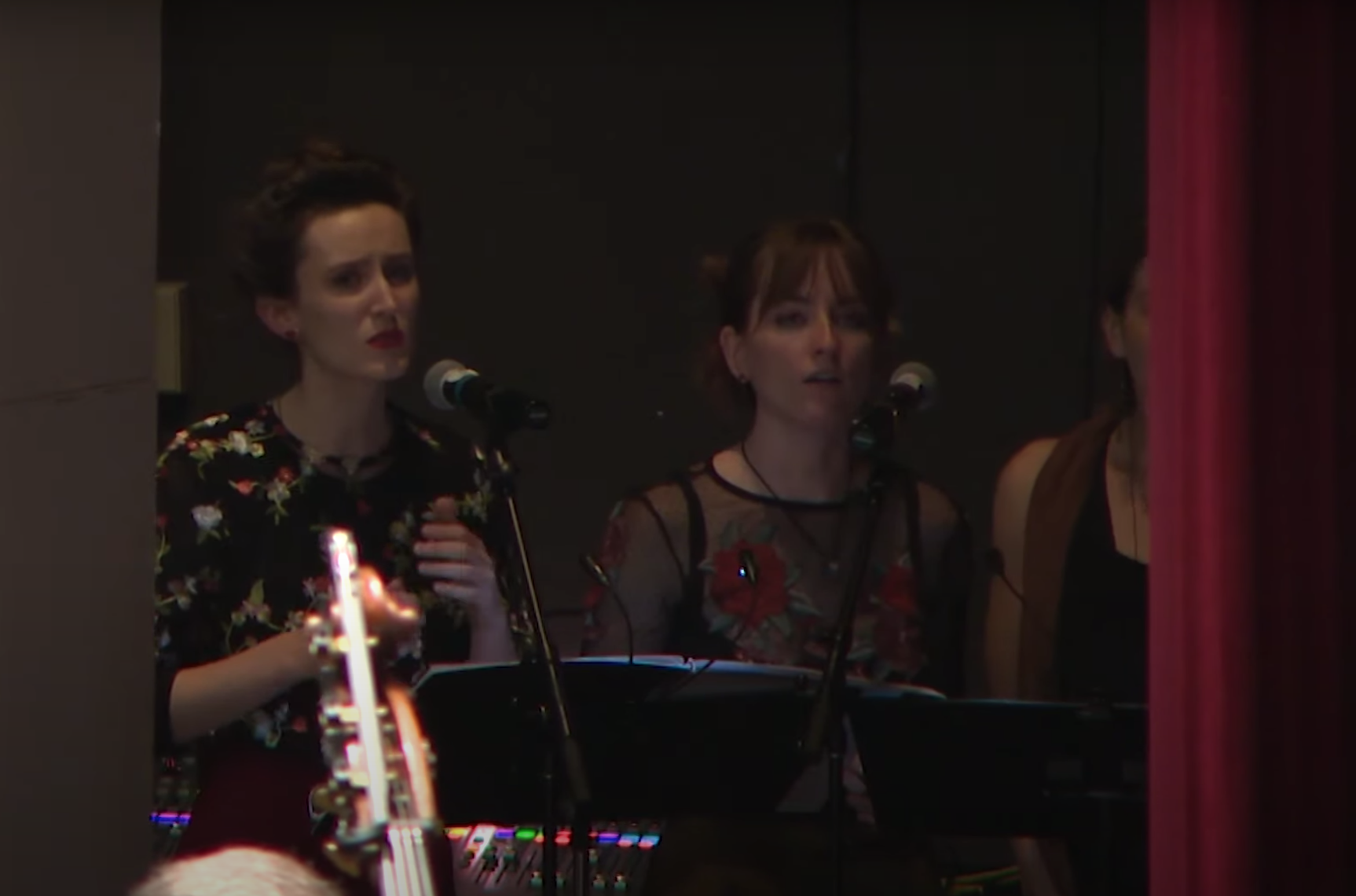 Backstage Angels: Celeste Oram, Lauren Jones and Barbara Byers (obscured)
Backstage Angels: Celeste Oram, Lauren Jones and Barbara Byers (obscured)
How do you use found materials in this piece? Why did you choose these particular things?
(Celeste) A lot of my work directly references other music, often to foreground the cultures of transmission and listening around that music. You could say this is a journalistic approach to composition. But, also, it feels like a sincere and transparent grounding in what composition is: a practice of assembly, adaptation, responsiveness.
Again, Cassandra Miller’s ‘Duo for Cello and Orchestra’ was an important influence. With audaciously few musical materials, that piece conjures an extraordinary universe of sound and meaning. Similarly, with this piece I started with a modest fund of musical material that guided me through processes of transcription, translation, transformation - and thus makes “my hand” (my technique, i.e. my knowledge) quite conspicuous.
So the “material” in this piece comes from music that, quite simply, I love - but that I sense I need to come to terms with precisely why I love it. My focus was first with the winds, whom I decided would be responsible for “singing” the verses and bridge. (The offstage angel popstars would get the chorus.) The wind parts are based on fragments from a couple of pieces of European church music. One is an anonymous two-voice hymn from the 12th century, Ad superni regis. Then there are some fragments from Giovanni Gabrieli’s grand 16-voice ‘sacred symphony’, Exaudi me Domine, from the early 17th century. Writing new counterpoints to existing music is a method of “composing” that I enjoy, so at times I embroider these materials with a third additional voice, then a fourth, and so on and on. But I’m not trying to write 12th century counterpoint as such; the additional lines are a bit “extra”, a bit wild. I'm transforming material via embellishment and saturation. I also adapt voice-leading mechanisms from these materials that grab my ear as both musically sensuous and technically interesting. I “learn” these contrapuntal “tricks” in order to test out what else they can do, to probe their outer harmonic and expressive limits.
And then Keir is kind of the one-man band holding all these chaotic voices together. Keir’s solo violin part largely consists of a harmonic progression with three voices - so it’s a puzzle, or a juggling act, given that you can really only play two sustained notes at once on the violin. That contrapuntal negotiation is absolutely Keir’s wheelhouse, though - hence why I gravitated towards it. serpentwithfeet is a vocalist and composer based in Brooklyn whose music is exquisite, and there’s this harmonic turn in their song “redemption” that got stuck in my head while I was working on this piece: a falling line that comes to rest on a minor tonic, but then the third raises to become the V of iv. It reminded me somehow of a piece that Keir plays a lot - a 17th century solo violin suite by Johann Paul von Westhoff - that oscillates between a minor tonic and the dominant minor in ways that make you go, wait, which is the tonic here? Or, in plain terms, where does the phrase actually come to rest? So those harmonic illusions I repurpose as this churning, never-ending harmonic phrase which *continues* on and on without *developing* in the way one might expect from a Romantic concerto.
And there are other Easter eggs too - dozens of stray alleluias (from Gregorian chant), as well as “a bright light”, “a dry wind”, “the dead sand”, etc. (No lasers in the jungle, though.) I don’t reference the ‘The Boy in the Bubble’ song for its musical content. Rather, I empty the song of everything but its formal skeleton (verse-chorus-etc.), mythic images (the aforementioned lyrics), and sonic illusions (the bucketloads of 80s reverb, the fadeout) - and translate these relics into the orchestral score.
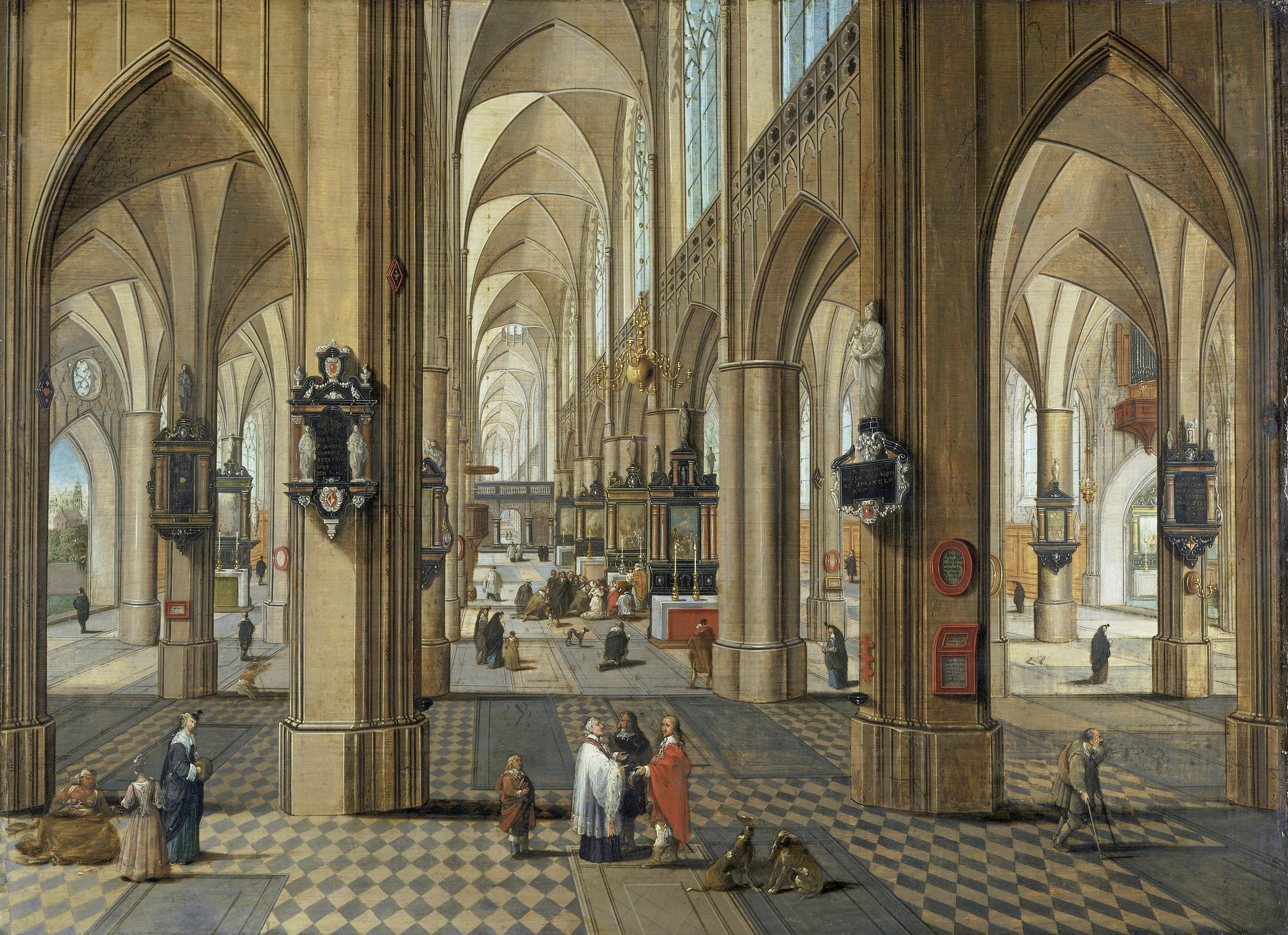 Pieter Neefs, 'Interior of Antwerp Cathedral'. "I only came across the image after the piece was written, but I think it's a nice "synopsis", so to speak" - Celeste Oram
Pieter Neefs, 'Interior of Antwerp Cathedral'. "I only came across the image after the piece was written, but I think it's a nice "synopsis", so to speak" - Celeste Oram
There are so many rich, seemingly free-associative connections within this work. You’ve described it as “an invitation to listen to and through familiar strains accumulated into a disorienting density”. As a composer, how do you find these connections, and how do you make your way through this thicket of ideas to arrive at a finished work?
(Celeste) In one sense, the connections in this piece are intensely personal, almost autobiographical - it’s me trying to parse my own musical inheritances and understandings. That accounts for the defining presence of historical European church music, because that’s a big part of my musical ancestry. That repertoire—its techniques, its purpose, its logic of expression—makes so much sense to me; it has—for better or worse—shaped my understandings of “the musical”, “the spiritual”, “the expressive”.
And then there’s the Graceland album, which my family listened to on road trips so much when I was a kid that I knew all the lyrics by heart before I really knew what all the words meant, in the same way I learned the Lord’s Prayer or the Nicene Creed.
So, yes, I think “free associative” is an apt description. But by its intensely personal nature, "free associative" in this piece doesn’t mean random or arbitrary. This piece is me trying to do musical genealogy, trying to take stock of my sedimented knowledge. I’m intentionally embarking on that task because I—like many of my peers—am sitting with the fact that I have considerable personal and professional investments in a musical tradition whose values and transmission is inextricable from its affiliation with imperial might, colonisation, and white supremacy. It is what it is, as Michelle Obama might say.
It’s worth keeping within view where much of the musical material in this piece comes from. The 12th century hymn is from the Codex Callixtinus, a guidebook for pilgrims on the Camino de Santiago; the hymn is a paean to a saint whose cult boomed with the slaughter and exile of non-Christian and African communities in the Iberian peninsula. Gabrieli’s professional life was devoted to amplifying the splendour of the Papal empire at a time when it was desperately clamouring to preserve its spiritual and political monopoly in the face of the Reformation. And in making Graceland, Paul Simon broke UN sanctions to travel to South Africa at the height of apartheid. It is a damn catchy album that has given many people across generations genuine musical pleasure, perhaps even emotional meaning. It is also a sad cliche of a middle-aged American finding his way out of the creative doldrums and a broken marriage via the “redemption” of African cultures, amassing considerable wealth in the process. It is what it is.
What the piece ultimately plays out is a fantasy of that whole cathedral burning to the ground, or being swallowed by the ocean, or otherwise succumbing to the sensationally eschatological fate promised by certain gods when judgement is necessary, when the world needs to be flooded and built over again. But this is patently not a solution. That fantasy, in fact, is distastefully indulgent. The orchestra rubbing their hands at the end - that could suggest a lot of things: perhaps ghostly applause, or prayer, or seeking warmth, or the soothing sound of calmer waters, or washing one’s hands of something.
And then your question is really its own answer - how do I make my way through this thicket of ideas to arrive at a finished work? Composing this piece was an introspective exercise in me trying to understand my own musicianship: the ancestry of my understandings of musical expression, beauty, and value. I would call this my “inheritance”, rather than my “skills”, because it all comes from somewhere; it’s not “mine” - though I am currently its custodian, and so need to figure out what (not) to pass on.
There’s more to say about connections and associations; at a certain point the string players have to profess whether or not they are generally in good health, for instance - and why are those angels so giggly? But I’ll leave it there, with the conclusion that I designed this piece to be a like a giant fresco or tapestry, embroidered with symbolism. Not for the sake of being brainy - but because the interpretation and unriddling of symbolism is how we take stock of shared knowledge. The quote from the programme note you mention basically primes the listener to expect that.
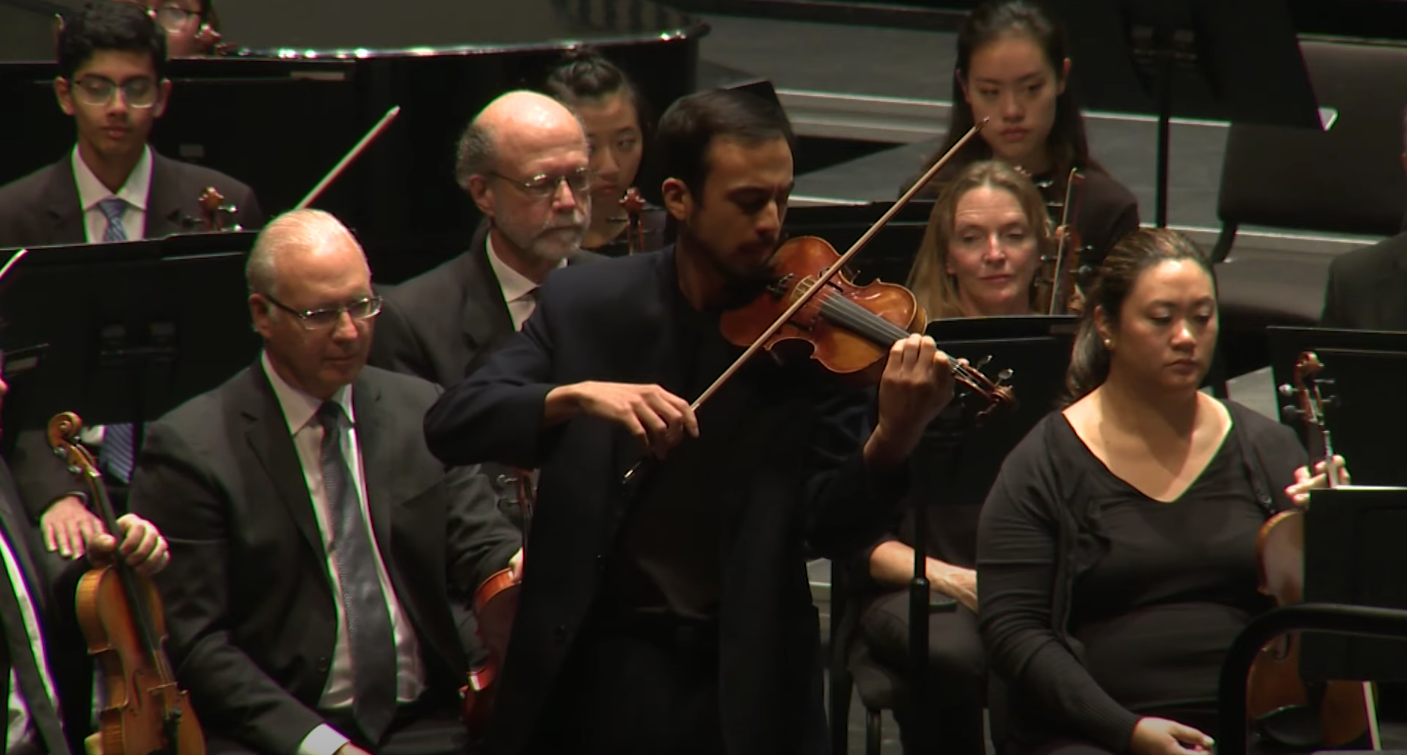 Keir GoGwilt (violin) with the La Jolla Symphony Orchestra.
Keir GoGwilt (violin) with the La Jolla Symphony Orchestra.
You are regular collaborators (Tautitotito, Televisionmann, Craigie Hill…). How did you first start working together?
(Keir) Televisionmann was our first collaboration, and I think of it as a first attempt to combine my personal investment in 18th century European art music repertoire and performance, with Celeste’s compositional interests, which at the time were using technologies like radio, television, and audiovisual scores. The title, Televisionmann, puts it together: Telemann + Television. The television/green screen aspect of the piece allowed us to bring in a lot more of the world than 18th century art music and the cloistered space of the concert hall affords – Celeste filmed me playing Telemann in locations including outside Kamala Harris’s regional San Diego office and at an airport protest against the first instantiation of the Muslim ban.
Tautitotito was another example of a piece that used all sorts of technological mediations to build a world outside the concert hall. It was a mammoth undertaking – a 3-hour long, poly-stylistic magical radio show, which moved through several periods and places of Aotearoa, weaving together historical fictions, hypothetical realities, and speculative futures. There were many people who came together to make the piece happen – Rob Thorne, Alex Taylor, and Madison Greenstone were particularly involved in its co-creation.
More recently our collaborations have fitted that “outside” into crafted musical-poetic spaces. Craigie Hill, for example, is based on the traditional Irish song by the same name. We were particularly inspired by Dick Gaughan’s highly ornamented and loosely metrical rendition. And Celeste’s violin concerto is a post-postmodern pastiche that includes everything from high Germanic Romanticism to Renaissance polyphony to Paul Simon’s Graceland. These musics are clustered within, and built out of contexts of colonization, apartheid, and fascism. But unlike Televisionmann or Tautitotito, which were really about making these clusters and connections explicit, “a loose affiliation of alleluias” lets it all remain behind the curtain.
How is improvisation integrated into ‘a loose affiliation of alleluias’?
(Keir) I think it’s worth mentioning here that ‘improvisation’ here is different from jazz or what some AACM members termed Great Black Music. I’ve continually looked to Great Black Music for creative paths forward, but in the context of this concerto I’m drawing from an understanding of ‘improvisation’ and spontaneity particular to 18th and 19th-century European formations. In a lot of literature in the 19th and 20th centuries, you see performers looking to make spontaneous expression emerge from entirely notated musical figurations. My feeling with this concerto is that it straddles romantic conceptions of spontaneity – the vitalist imperative to re-animate the ‘dead letter’ of the score –, and the earlier 18th-century tradition, in which instrumentalists would actually just make up a lot of notes within and around the notes on the page.
There are specific, but simultaneously quite open instructions for the soloist. Keir, how do you go about interpreting an improvised solo part? Did you have much input during the composition process?
(Keir) Celeste and I are constantly talking to each other about our work-in-progress, but for this piece we set some definite limits about its division of labour. I really didn’t see the score until it was fully notated, though I heard some of her early mock-ups and basically just told her I thought they sounded great.
I appreciate that you phrased the first question the way you did, because it certainly does still feel like a process of interpretation: I’m parsing the prosody of musical phrases, looking at the large-scale form of the piece, and trying to figure out what my role in it is. In the opening sections of the piece, my ‘improvisations’ are confined to little ornaments and embellishments. Leading up to the more climactic middle and ending sections, the improvisations become more involved. I think of them as increasingly ornate developments and departures from the musical materials, which follow the intervallic logic of given sequences, or which occasionally mimetically respond to a piccolo line.
The Romantic concerto literature is replete with examples of the soloist sending off a final triumphant chord before being crushed by a cresting tutti orchestral sound. It’s the perfect sound-byte for the bourgeois fascination with heroic and sublime annihilation. It relies on extravagant tastes and extravagant means (a symphony orchestra, for example). Celeste definitely has a few of these moments of sublime annihilation in “a loose affiliation,” and she employs them masterfully. We didn’t know when we’d next have the opportunity to make such an effect happen, so we figured we might as well enjoy it while we could.
